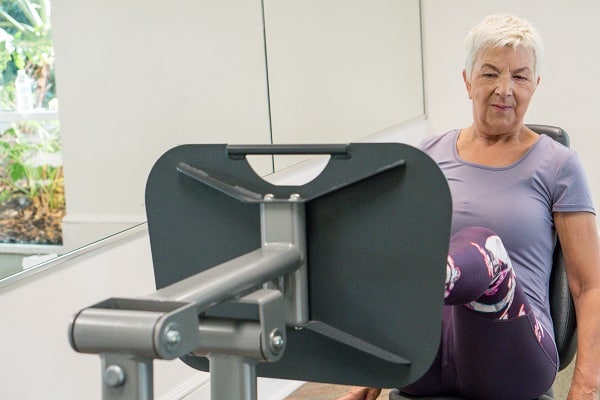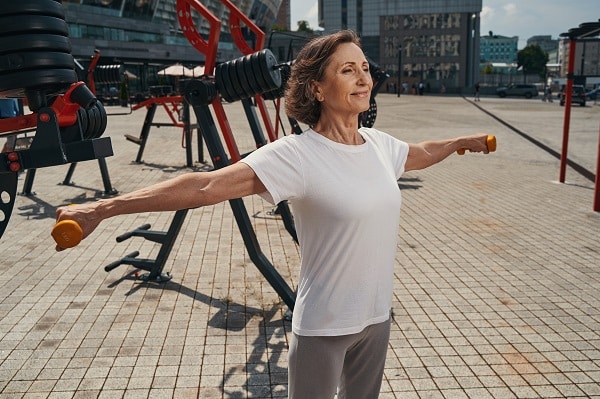As you journey through life, the inevitable process of aging brings about numerous changes to your body. While some of these alterations are natural and expected, others can significantly impact your quality of life. One such change is the gradual loss of muscle mass and strength, which can hinder your daily activities and overall well-being. However, there’s a powerful tool to counteract these age-related challenges: weight training. This form of exercise not only combats muscle loss but offers a myriad of other benefits that are crucial as you age.
Contents
- The Reality Of Muscle Loss With Age
- Benefits Of Weight Training For Bone Health
- Weight Training And Metabolism
- Improving Balance And Coordination
- Mental Health Benefits
- Enhancing Flexibility And Mobility
- Weight Training Vs. Cardio: A Balanced Approach
- Getting Started: Tips For Seniors
- Overcoming Common Barriers
- Start Reaping The Benefits Of Weight Training!
- Related
The Reality Of Muscle Loss With Age

Muscle loss, scientifically termed as sarcopenia, is a natural phenomenon that begins as early as your 30s. With each passing decade, you can lose between 3% to 5% of your muscle mass if you’re not proactive. This decline can lead to frailty, increased risk of falls, and a decreased ability to perform everyday tasks. Activities that once seemed trivial, like carrying groceries or climbing stairs, can become daunting challenges.
However, it’s not just about muscle volume. The quality of your muscles also deteriorates, leading to reduced strength and endurance. This decline can be attributed to factors like hormonal changes, reduced physical activity, and inadequate protein intake. But, regardless of its cause, the effects of muscle loss are profound and can significantly impact one’s independence and quality of life.
Benefits Of Weight Training For Bone Health

Your skeletal system, much like your muscles, undergoes changes as you age. Bones lose their density, becoming more fragile and susceptible to fractures. Osteoporosis, a condition characterized by weak and brittle bones, becomes a looming threat, especially for post-menopausal women. However, weight training offers a beacon of hope. When you lift weights, the stress applied to your bones stimulates the bone-building cells, leading to increased bone density.
Beyond just prevention, weight training can even reverse some of the bone density loss that has already occurred. Real-life examples abound of seniors who, through consistent weight training, have not only halted the progression of osteoporosis but have regained bone strength. This fortification of the skeletal system is crucial in reducing the risk of fractures, which can be life-altering events for older adults.
Weight Training And Metabolism

A slowing metabolism is another hallmark of aging. As your metabolic rate decreases, you burn fewer calories at rest, leading to weight gain and associated health issues. One of the primary drivers of your metabolism is your muscle mass. Muscles are metabolically active tissues, meaning they burn calories even when you’re not actively using them. Thus, a decline in muscle mass directly correlates with a drop in metabolic rate.
By engaging in weight training, you can counteract this decline. Building and maintaining muscle mass ensures a higher resting metabolic rate, which in turn aids in weight management. Moreover, the act of weight training itself burns calories, providing a dual benefit. For seniors, this metabolic boost is invaluable, helping to maintain a healthy weight and reduce the risk of obesity-related diseases.
Improving Balance And Coordination

As you age, your sense of balance and coordination can diminish, increasing the risk of falls and injuries. This decline is not just due to muscle loss but also changes in your nervous system and a decrease in proprioception, your body’s ability to sense its position in space. Weight training, however, can be a game-changer. By strengthening both major and stabilizer muscles, it enhances your body’s stability and reduces the likelihood of falls.
Furthermore, weight training exercises, especially those that engage the core and require multi-joint movements, improve coordination. For instance, exercises like squats or lunges not only build leg strength but also challenge and enhance your balance. Over time, as strength and coordination improve, daily activities become safer and more manageable, fostering independence and confidence in seniors.
Mental Health Benefits

Physical health is just one aspect of your well-being; mental health plays an equally pivotal role, especially as you age. Depression, anxiety, and feelings of isolation can become more prevalent in your later years. Engaging in weight training can act as a buffer against these challenges. The act of lifting weights releases endorphins, the body’s natural mood elevators, which can alleviate feelings of sadness or anxiety.
Beyond the biochemical benefits, weight training also fosters a sense of accomplishment. Setting and achieving fitness goals can boost self-esteem and provide a sense of purpose. Regular exercise can provide structure to one’s day, and the visible results – be it increased muscle tone or improved posture – can instill a renewed sense of self-confidence, proving that age is just a number.
Enhancing Flexibility And Mobility

A common misconception is that weight training leads to reduced flexibility. On the contrary, when done correctly, it can enhance flexibility and overall mobility. Strength training exercises, when paired with proper stretching, can improve the range of motion around joints. For instance, a full-range squat not only strengthens the leg muscles but also promotes hip flexibility.
Joint health is another crucial aspect of mobility. As you age, your joints can become stiffer and more prone to ailments like arthritis. Weight training strengthens the muscles surrounding these joints, providing them with better support and reducing strain. This combined improvement in muscle strength, joint health, and flexibility ensures that seniors can move with ease, grace, and less pain, making daily activities more enjoyable.
Weight Training Vs. Cardio: A Balanced Approach

While weight training offers numerous benefits, cardiovascular exercise remains essential for overall health. Cardio exercises, like walking, swimming, or cycling, improve heart health, lung capacity, and endurance. However, relying solely on cardio can lead to muscle loss, especially in seniors. Thus, a balanced approach that combines both weight training and cardiovascular exercise is optimal for holistic health.
Incorporating both forms of exercise ensures that while the heart and lungs are getting their workout, the muscles are also being strengthened and preserved. This combination not only enhances physical capabilities but also ensures better protection against diseases like heart disease or diabetes. For seniors, striking this balance can lead to a more active, healthier, and fulfilling life.
Getting Started: Tips For Seniors

Embarking on a weight training journey, especially later in life, can seem daunting. However, with the right approach, it can be both safe and enjoyable. Before diving in, it’s paramount to consult with a physician to ensure that specific exercises or routines are suitable. This step is crucial, especially if there are pre-existing health conditions or concerns.
For beginners, it’s essential to prioritize form over the amount of weight lifted. Proper technique ensures that the right muscles are targeted and reduces the risk of injury. Starting with lighter weights and gradually increasing as strength builds is a wise approach. Additionally, considering guidance from a trained professional or joining a senior-specific weight training class can provide the necessary support and direction.
Overcoming Common Barriers

It’s natural to encounter obstacles when starting something new. For seniors, barriers to weight training might include fear of injury, misconceptions about capabilities, or even logistical challenges like transportation to a gym. Recognizing these barriers is the first step to overcoming them. For instance, for those concerned about injury, starting with resistance bands or body-weight exercises can be a gentler introduction.
Time constraints or lack of access to a gym can be addressed by incorporating home-based exercises or routines that require minimal equipment. The key is consistency and finding a routine that aligns with individual preferences and circumstances. With determination and the right resources, these barriers can be surmounted, paving the way for a healthier aging journey.
Start Reaping The Benefits Of Weight Training!
The golden years of life should be marked by vitality, independence, and joy. While aging is a natural process, how you age is, to a significant extent, within your control. Weight training emerges as a powerful ally in this journey, offering a plethora of benefits that extend beyond just physical health. By embracing strength training, seniors can combat muscle loss, enhance bone health, boost metabolism, and foster mental well-being. The journey might come with challenges, but the rewards – in terms of health, confidence, and quality of life – are immeasurable. Embracing weight training is not just about adding years to life but adding life to years!


